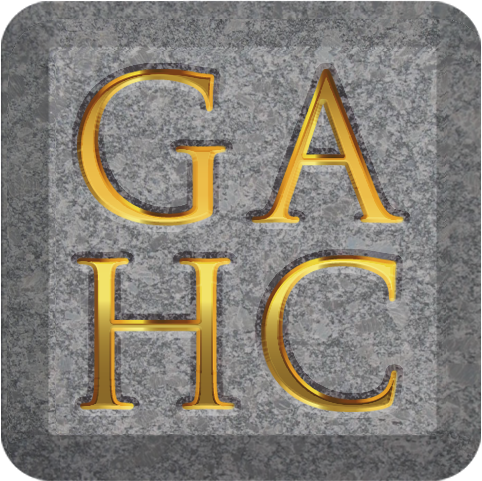A painting by William G. Yorke that depicts America's Cup champion Columbia in 1881, shortly before she was purchased by Henry Flagler. Flagler Museum Collection.
What do bananas, the overthrow of a government, and Henry Flagler have in common? The answer: Henry Flagler's yacht Alicia.
Like other titans of America's Gilded Age, Henry Flagler enjoyed yachting and was a member of many yacht clubs, including the New York Yacht Club, where he registered his private signal flag or burgee. Flagler purchased Eclipse, his first yacht, around 1883, but he owned it only briefly. Eclipse was built by C.A. Willis in 1881 and its overall length was about 55 feet. Flagler's second yacht, the schooner Columbia, was purchased in 1884. Built in 1871 for Franklin Osgood, Columbia became world famous when in that same year it successfully defended the America's Cup, along with Sappho. About 108 feet long with a beam of about 25 feet, the Columbia drew just over eight feet and displaced just over 100 tons.
In 1890 Henry Flagler decided to build his own new yacht, which he named Alicia, after his wife Alice. It would be, by far, his largest yacht. Harlan and Hollingsworth of Wilmington, Delaware received the commission to build a two-masted schooner, with a three-cylinder steam engine. The Alicia's overall length was 180ft, its length along the waterline was 160ft, its displacement was just over 300 tons, its beam was 24ft, and its draft was 9ft 6in. At a cost of about $113,000 (about $3,000,000 in today's money), the Alicia was a substantial investment. Flagler must have been proud of the Alicia, as it was the only one of his yachts for which he commissioned a painting.
Henry Flagler’s steam yacht Alicia, 160’ long at the waterline, custom built in 1890 by Harlan and Hollingsworth of Wilmington, Delaware. Library of Congress.
Like Columbia, the Alicia was involved in an America's Cup race, however in the Alicia's case not as a competitor, but as a patrol or committee boat. Henry Flagler and the Alicia were chosen to serve as a captain and patrol vessel during the 1895 America's Cup race, when an American sloop designed by the legendary Nathanael Herreshoff named Defender successfully defended the Cup by defeating the British cutter Valkyrie III. To commemorate the occasion and thank Flagler for his participation, New York Yacht Club Rear Commodore Bergen commissioned a cigar humidor from Tiffany & Co.
Mahogany, silver, and enamel humidor made by Tiffany and Co. in 1896. Flagler Museum Collection.
When the United States hastily declared war against Spain in 1898, it did so without much in the way of a navy - the Great White Fleet was yet to be created by Theodore Roosevelt. Since war with Spain would necessarily involve naval battles and blockades, in order to bring the Navy quickly up to par, Congress authorized the purchase of more than 100 private yachts and corporate ships, among them: JP Morgan's Corsair, Ogden Goelet's Mayflower, J.D. Spreckels' Fearless, two Standard Oil ships Atlas and Hercules, and Henry Flagler's Alicia. The Navy removed the aft mast of the Alicia and renamed it the USS Hornet, immediately sending the ship into battle where it quickly developed a reputation as a capable Navy ship. In April of 1898 the USS Hornet seized the English schooner Nickerson, with its Spanish crew, trying to run the blockade off Manzanillo, Cuba. Shortly thereafter, the Hornet and two other ships sank a Spanish gunboat. Later that same day the same group of three U.S. ships entered Manzanillo Harbor and immediately engaged in battle. The steam pipe on the Hornet was blown away, but the Hornet continued to fight and sank a Spanish sloop.
A painted and needlework portrait by Thomas Willis of Henry Flagler's steam yacht Alicia, 160' long at the waterline, custom built in 1890 by Harlan and Hollingsworth of Wilmington, Delaware. Flagler Museum Collection.
By July the Hornet had been repaired and was back in action near Santa Cur del Sur cutting under water telegraph cables. It wasn't long before the Hornet saw action again in Manzanillo Harbor where the American fleet sank nine Spanish ships in an hour and 40 minutes of heavy fighting. By August the Hornet was back in Key West and by October 1898 it was decommissioned and loaned to the Naval Militia of North Carolina where it served until 1902. The Hornet was then sent to Norfolk , where it served as a tender to the Franklin for the next eight years. In 1910 the Hornet was decommissioned and sold to a broker in New Orleans.
Until the summer of 2012, that's all that was known to historians about the storied life of the Alicia (later known as the USS Hornet). However, that was far from being the end of the Alicia's story. Instead, the Alicia was about to begin another interesting chapter in its history. A phase in which it would play a critical role in shaping the geopolitical landscape. But, more about that later.
For more than a century bananas have been the most popular fruit in America. But, it wasn't always so. It is very unlikely that Henry Flagler ever even saw a banana until he was well into his adult life. In the mid-nineteenth century bananas were a very rare fruit, known only to the wealthiest of Americans. But thanks to the United Fruit Company and an extraordinarily scrappy and ambitious young Russian immigrant named Samuel Zemurray, that all changed in the late nineteenth century.
Dinghy Transom from Henry Flagler's Steam Yacht Alicia, ca. 1890. Collection of Lamont Harris.
Having seen his first banana in 1893 for sale by a peddler in Selma, Alabama, Sam Zemurray was smitten. Working like a dog and risking everything again and again, Sam went from buying and selling "ripes," as the freckled bananas that would not survive long shipments were known, to owning thousands of acres of banana plantations in Central America. He spent part of each year in New Orleans, with his wife and children, and the rest in Central America, making sure he knew the banana business literally from the ground up. By 1910 Sam owned at least 18% of the U.S. banana market, which was saying something, as by then bananas had become the most popular fruit in America. In fact, Sam Zemurray was the only truly serious competition United Fruit had. United Fruit owned thousands of acres of banana plantations, primarily in Nicaragua, while Sam owned thousands of acres, primarily in Honduras.
Having contracted in 1870 for the construction of a railroad between the Pacific and Atlantic, Honduras was in deep financial trouble. Apparently, the contract for the construction of the railroad was based on per mile of track completed and the contractor happily laid 60 miles of meandering track, that never even came close to spanning Honduras from sea to sea, before the company went bust. By 1900 Honduras owed London bankers and bondholders about 100 million dollars. By 1910 Honduran President Miguel Dávila, desperate to find a way out of the country's crushing debt, asked for America's help. And, he got what he was looking for. Secretary of State, Philander Knox, worked out an agreement with J.P. Morgan to buy all the outstanding bonds for 15 cents on the dollar, provided a Morgan representative would be stationed at the Custom House in Puerto Cortés to collect duty on all exports. It was a classic Morgan move.
The problem with the Knox Plan, at least as far as Sam Zemurray was concerned, was that it would mean additional taxes on the bananas being exported and that would mean the end of Zemurray's banana business. So Sam, following a time-honored tradition, hired Washington lobbyists to undermine the Plan. When Sam's lobbying efforts attracted Secretary Knox's attention, Knox became so furious he summoned Zemurray to Washington, where he pointedly explained that the Plan was more important than Sam's banana business and that there was no stopping it now.
For Sam Zemurray, allowing his banana business to collapse was simply unacceptable. So, thinking that a change in the presidency of Honduras would mean the Plan would be rendered moot, Zemurray immediately set about figuring out how to orchestrate a Honduran revolution. Obviously, Sam Zemurray didn't fully appreciate the fact that he "couldn't" simply defy two of the most powerful men in America and stage his own private revolution.
It just so happened that the former President of Honduras, General Manuel Bonilla, had been living in exile in New Orleans since he was deposed in 1907. And that, he was a close friend of none other than Sam Zemurray. It also just so happened that New Orleans was filled with adventurers and mercenaries more than willing, for the right price, to embark on yet another mission. Sam set about immediately rounding up the "usual suspects" for his Honduran "revolution."
Zemurray's first attempt to stage a Honduran revolution failed spectacularly. Undeterred Zemurray believed a successful revolution could be mounted if the Knox Plan could be cast as some sort of American hegemony, which friendly Honduran reporters were only too happy to do, and if he added a warship to his small army of about 100 mercenaries. Working secretly through an agent in New Orleans he found and purchased his warship, which was none other than the former USS Hornet (formerly the Alicia). With a top speed of 15 knots, the Hornet was faster than any ship in the Honduran navy.
USS Hornet off the Norfolk Naval Yard, VA. December 19, 1898. NHHC Photograph Collection.
Secretary Knox got wind of the sale of the Hornet to Zemurray and assigned the Secret Service to monitor Zemurray's every move in New Orleans, hoping to keep Sam Zemurray from engaging in any activity that might upset the Plan and embarrass Uncle Sam. Employing clever subterfuge, Zemurray, Bonilla, and the leaders of the group of mercenaries managed to slip out of the harbor in New Orleans just before Christmas 1910 and rendezvous with the USS Hornet, which had left the harbor several days before, supposedly to pick up a shipment of iron ore in Nicaragua. In fact, however, the Hornet was loaded with a large shipment of a very different kind of iron - rifles, grenades, and ammunition. A few days later, veiled in dense fog, the Hornet sailed into the harbor of the island of Roatán, just before New Year's Eve 1910. The mercenaries quickly captured the old Spanish fort there and the Hornet was immediately sold to a Honduran citizen so that the ship could take part in the Honduran "revolution" without violating the United States Neutrality Act. The Hornet then mounted a successful attack on Trujillo on January 9th, but was seized by the U.S. Gunboat Tacoma (ironically another privately owned ship purchased for use during the Spanish American War) and towed back to New Orleans to be held as evidence. By then, however, the revolution was well underway and the Hornet was not missed. By early January Honduran President Dávila agreed to a cease-fire and on the deck of the USS Tacoma the President agreed to resign and cede power to a functionary until an election could be held. A few months later, General Bonilla, the now "hero" of the revolution, was elected President by a landslide. Almost immediately, the new President quickly granted his friend and benefactor, Sam Zemurray, concessions for his banana trade for the next quarter century.







